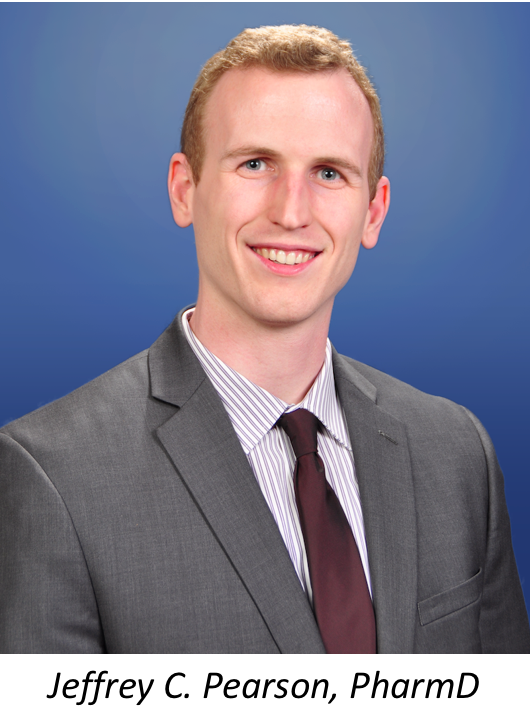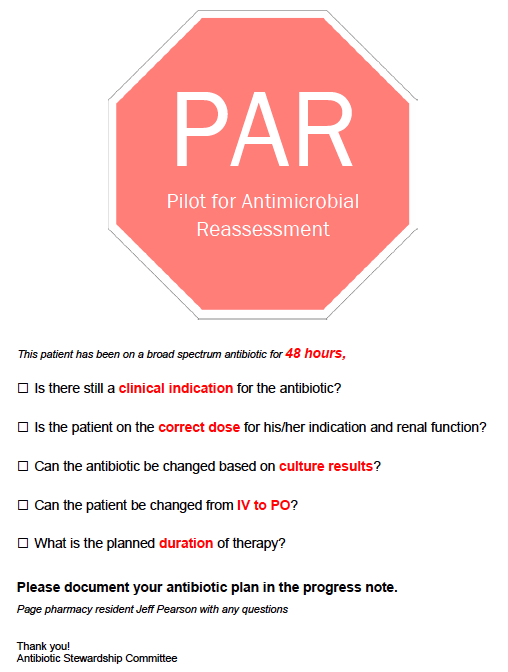Reminding Clinicians to Self-Assess Patients' Antibiotics Helps Reduce Duration of Therapy
A study shows that pharmacist-driven education and encouragement of antibiotic self-stewardship can decrease the duration of therapy for broad-spectrum antibiotics.

A new study has shown that pharmacist-driven education and encouragement of antibiotic self-stewardship for a soft 48-hour time-out can result in a modest decrease in the duration of therapy for broad-spectrum antibiotics.
At the SHEA 2018 Spring Conference, Contagion® sat down with Jeffrey C. Pearson, PharmD, PGY-2 Pharmacy Resident in Infectious Diseases, from Beth Israel Deaconess Medical Center, in Boston, Massachusetts, who spoke with us about his poster presentation, “Impact of a pharmacist-driven education and antibiotic self-stewardship after 48 hours at a community teaching hospital.”
The IRB-approved, pre-post design, retrospective review was conducted January 2016 through March 2016 for the pre-intervention phase and January 2017 through March 2017 for the post-intervention phase. Patients admitted to a medical floor who were >18 years of age and who had received at least 1 order for cefepime, ertapenem, meropenem, piperacillin/tazobactam (pip/tazo), or vancomycin were included in the study. A total of 172 patients were included in the pre- and post-intervention phases for a total of 344 patients. The median age of the patients in the pre-phase was 77 years (range 65-86) and 74.5 (range 64.8-86) in the post phase. Forty-five percent of the patients in the pre-phase were female vs 52% in the post-phase.
Dr. Pearson shared more about the study design with Contagion®:
“It was a pre-post study design specifically looking at a 3-month time period, exactly a year before the intervention and then post-intervention. The study was designed that way—1 year apart—based on the residents’ time in their year at the hospital. It was a small community teaching hospital, and so residents would shuffle through every year. Based on that time of year [that we chose], they have more experience with antibiotics and how to treat patients. The pre-post design was specifically looking at the previous year’s class of fellows and residents.
The first part of the intervention was an educational piece consisting of providing education to pharmacists, providers, physicians, and nursing staff, on what stewardship is [and is not]. This was very basic information: what stewardship is and why it's important, and then providing actual data to back up why it’s important.
The education was provided in multiple sessions, both live and electronic. Live sessions were completed during morning meetings where all house staff meet to discuss patients that came in overnight. I provided the staff a quick 15-minute presentation for the team(s) multiple times. Anytime the house staff switched over, I would give the presentation again.
Then we also added in an electronic/online learning module at our institution called, Healthstream where staff can complete core competency training. An online version of the same lecture material from my presentation was uploaded, along with questions at the end to confirm that they completed the course. The link to the online learning course was sent out hospital-wide, to nursing, pharmacy, and physicians, as well as house staff, attendings, and surgeons.
Although we have a smaller-sized hospital (200 beds), we had almost 600 individuals complete the online course.”
Contagion®: What was the second part of the intervention?
Our hospital was working with paper charts at the time of the study. We created a reminder sheet on yellow cardstock that included a large stop sign with the acronym for the study: the Pilot for Antimicrobial Re-Assessment (PAR). That stop sign became the logo for the entire study, and so all staff in the hospital recognized the paper when they opened up the chart and saw the yellow page (see image below).

Only the charts of those patients who were on a broad-spectrum antibiotic for over 48 hours received the yellow reminder sheet. Our team tracked when patients were started on antibiotics, and as soon as it hit hour 48, I would go around to the different floors to put (the) reminder chart note into the chart. Because these notes were part of the pilot program, they were not part of the permanent medical record; they were removed when patients were discharged.
Contagion®: Was the process of manually putting these cards into patients’ charts time-consuming?
It was probably 15 minutes a day, and that was about the commute time to each of the floors to put the chart note in the chart. The goal of the intervention was not to perform a deep-dive into the patients themselves to see if the antibiotic they were prescribed was appropriate or not, but rather to remind the patients’ care team to reassess if the antibiotics were still needed.
Contagion®: What were the biggest challenges to implementing a 48-hour time out?
Any change of practice will always have a little bit of pushback because it's a change from what individuals have grown accustomed to. Especially with a time-out. In the past, there have been studies that looked at hard time-outs, where antibiotics were automatically stopped after a certain amount of time to then force renewal by the physician. Our team did not want to approach it like that because that could have created more pushback and had the potential to backfire in that patients might be stopped on their antibiotics when they still might be necessary. We were looking to bring in a soft time-out as a reminder, and I think the intervention succeeded because we were not pushing practice change. We were pushing practitioners to assess their practice, but not forcing them to do anything. I think that was the key: self-empowerment for the physicians to do their own reassessment of the antibiotics and getting that action into the culture for them to reassess not just at 48 hours, but, daily.
I think we tackled one of the biggest challenges right off the bat with the education piece. It is important to have buy-in from house staff—even the hospital in general—and we were lucky enough to have that from the top, down. Everyone embraced the program.
If the intervention was introduced without that education piece and without introducing staff to the action, there would have been pushback and questions about, “What's this stop sign in my patient chart? This isn't part of patient care.”
Of course, the gold standard would be prospective audit and feedback, where you can look into the charts and determine if the patient should be getting broad spectrum antibiotics. But, not all facilities have the resources for that. Our intervention was targeting smaller hospitals that do not have the same presence as academic medical centers. We wanted to improve antimicrobial stewardship in these settings.
Contagion®: What were your findings?
What we found with the results is that in every antibiotic that we intervened on, there was a reduction in the duration of therapy. Specifically, we saw a 3-hour reduction in time from the start of an antibiotic to antibiotic discontinuation (7.4% relative risk reduction, P = .18). This was even more noticeable when we looked at our workhorse gram negative broad-spectrum agents. The most-commonly used broad-spectrum agents at our institutions were piperacillin/tazobactam and vancomycin. We saw a reduction of around 18 hours per order (18% relative risk reduction) —which works out to almost a full day less—of piperacillin/tazobactam post-intervention.
Contagion®: What were the providers’ comments about the intervention?
The comments were vastly positive. Once it went into effect, the providers embraced the program. There was almost zero pushback. I was expecting to get bombarded with treatment recommendations because I had included my pager and phone numbers on the sheet being included in the patients’ charts, but I only received 1 page for the entire 3-month study period and no phone calls. This led me to believe that the clinicians understood the intervention.
Additionally, they liked the program and shared with me that it was a great reminder for them to reassess antibiotics, even though I was not personally involved in the patient's care. Many provided me with anecdotal stories on how they embraced the program. The staff knew me as “the stewardship guy” and so they would ask me questions, and, I think the fact that it was a soft time-out where they were doing their own reassessment and we were not pushing them to do anything, helped them to embrace it.
Contagion®: This intervention utilized paper charts; would it translate to electronic health records?
That has been a large topic of discussion around this study: Would the intervention translate to an electronic health record (where physicians are receiving pop-ups as well as other interactions that they are just bypassing)?
It’s a great question, and I wish I had data on that. You would not need any personnel time to deliver chart notes to the floors with an electronic intervention. Would the clinician actually read something that comes up on their screen though, or would it be lost to “alert fatigue” and become another box to check to get rid of the pop-up?
I don't have the answer currently, but you could hypothesize that the paper chart with the hard yellow cardstock is a lot easier, and more noticeable than 1 of the hundreds of pop-ups that many physicians have begun to ignore.
Furthermore, a key part of our intervention was that I would talk to the providers and have face-to-face interventions with them. You would not get that with an electronic reminder. That personal touch really helps. However, the type of intervention that we provided may no longer be appropriate in most hospital settings as the majority of institutions are moving over to electronic health records.
Contagion®: Based on the results of your study, what are some of your recommendations for antibiotic stewards who are thinking about implementing an intervention like this at their institution in the future?
I would recommend that if you have the resources, you should go with 1 of the more tried-and-true methods of antimicrobial stewardship, such as a prospective audit and feedback, a pre-authorization feedback, or a combination of both. The intervention that we used is specifically geared toward those smaller community hospitals that do not have the resources to implement a vast program.
Additionally, it needs to be noted that our study time period was not long enough to properly power it, and we do not have a definitive statistical significance; however, any active intervention is better than nothing on the stewardship side, particularly in smaller hospitals that are struggling to find a way to implement a stewardship program at their hospital. Education is probably the easiest, low-hanging fruit to pick in getting providers to self-steward themselves and reassess antibiotics each day of therapy.
And by ‘education’ I mean the educating them on reassessment and giving them the power to self-assess, not providing education on what to prescribe (in most cases). The majority of providers know why they are prescribing these antibiotics and they know what they're covering and why they started a patient on a certain antibiotic. Most are aware of the reassessment part; but, it helps to have that reminder to bring reassessment to the forefront of their mind. Because when you have a patient that has 8 different things going on, suddenly, the antibiotics they have been on for 6 days drop down to problem number 10 on a list of 10. What we were doing is helping to prioritize and move the antibiotic reassessment up on the problem list a little bit to make them more aware of what the patient is taking, and how long they’ve been taking it.
